A well-crafted Certified Nursing Assistant (CNA) cover letter is your first impression on a potential employer. It’s a critical tool that can significantly increase your chances of landing an interview and ultimately, your dream job. This guide provides a comprehensive overview of how to write a compelling CNA cover letter that highlights your skills, experience, and passion for patient care. We will cover everything from formatting tips to common mistakes to avoid, ensuring your application stands out from the competition and effectively showcases your qualifications. Let’s get started on creating a cover letter that opens doors to your future career.
Crafting the Perfect CNA Cover Letter
Crafting a perfect CNA cover letter involves more than just listing your qualifications; it’s about telling a story that resonates with the hiring manager and highlights your suitability for the role. This includes a strategic approach to showcasing your relevant skills and experiences, tailored to the specific job requirements. Your cover letter should be a concise, yet compelling narrative that complements your resume and provides deeper insights into your personality, work ethic, and career aspirations. The goal is to demonstrate why you are the ideal candidate and make the hiring manager eager to learn more about you during an interview.
Understanding the Importance of a Cover Letter
A CNA cover letter serves as a crucial introduction to your professional self. It’s an opportunity to demonstrate your communication skills, passion for healthcare, and genuine interest in the position. It provides a space to elaborate on your resume, offering specific examples of how your skills align with the employer’s needs. Unlike a resume, which is typically a list of accomplishments, your cover letter should convey your personality and enthusiasm. It allows you to explain any gaps in your employment history, showcase your soft skills, and personalize your application. By investing time in a well-written cover letter, you increase your chances of making a strong first impression and setting yourself apart from other candidates.
Key Components of a Strong CNA Cover Letter
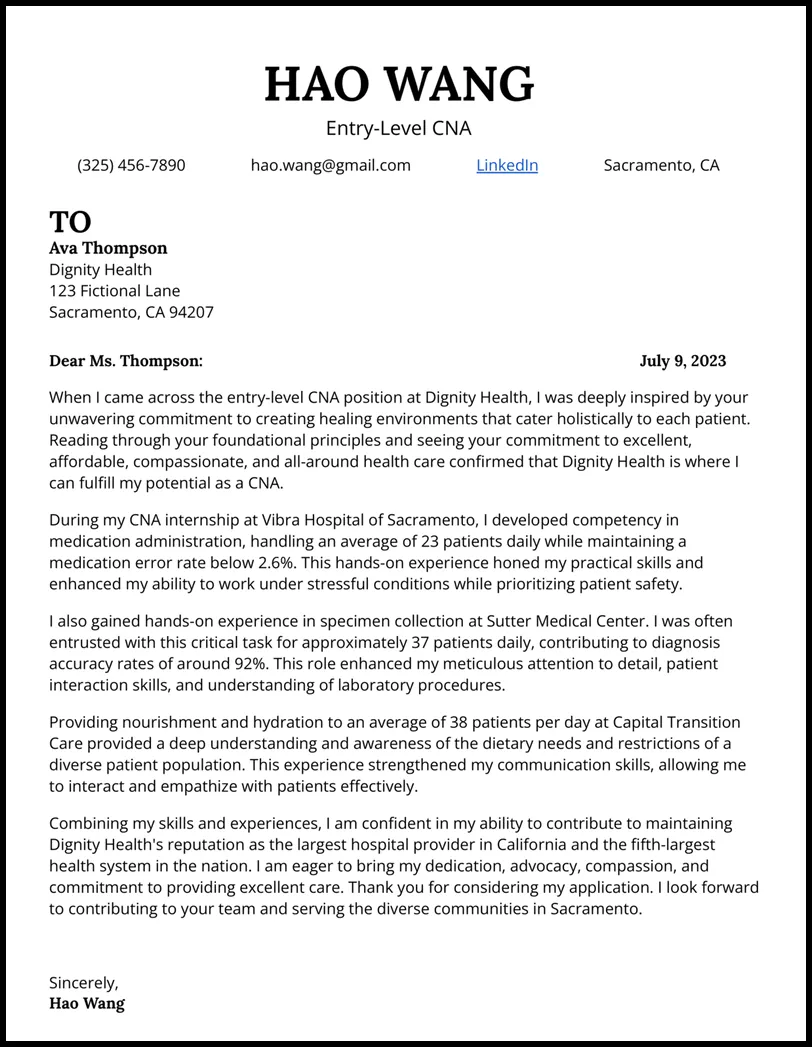
A strong CNA cover letter should include several key components to effectively communicate your qualifications and enthusiasm. These components work together to create a cohesive and compelling narrative. Each part plays a vital role in convincing the hiring manager that you are the right fit for the job. Start with a professional and respectful tone, and then delve into the details that highlight your value as a candidate. Structuring your cover letter correctly enhances its impact and ensures that the essential information is easily accessible and engaging for the reader.
Contact Information and Salutation
Begin your cover letter with your contact information, including your name, address, phone number, and email address. This information should be clearly displayed at the top of the page. Following your contact information, address the letter to the hiring manager, if possible. Research the company’s website or LinkedIn to find the hiring manager’s name; a personalized greeting shows you have taken the initiative to learn about the organization. If you can’t find a name, use a professional salutation like ‘Dear Hiring Manager’. This initial step sets the tone for the entire letter and demonstrates your attention to detail and professionalism.
Highlighting Your Skills and Experience
The body of your cover letter is where you showcase your relevant skills and experience. Start by stating the position you are applying for and where you saw the job posting. Then, briefly highlight your key skills, such as patient care, vital sign monitoring, assisting with daily living activities, and communication with patients and their families. Provide specific examples of how you have used these skills in past roles. For instance, describe a time when you provided exceptional care to a patient or successfully managed a difficult situation. Use action verbs to describe your accomplishments and quantify your achievements whenever possible.
Showcasing Relevant Certifications and Training

Clearly state your CNA certification and any other relevant certifications or training you possess. This is a vital section of your cover letter, particularly in healthcare. Include the name of the certifying institution and the date of your certification. If you have completed any additional training, such as CPR/First Aid, specialized patient care courses, or experience with specific medical equipment, be sure to mention these as well. Highlighting your qualifications demonstrates your preparedness and commitment to providing excellent patient care. Ensuring these details are included provides the employer with assurance of your competence and capabilities.
Quantifying Achievements
Use quantifiable achievements to make your cover letter more impactful. Instead of saying ‘Provided excellent patient care,’ provide details such as, ‘Administered medications to over 20 patients daily with 100% accuracy.’ When discussing previous responsibilities, use numerical data to demonstrate the impact of your work. For example, mention that you ‘Reduced patient falls by 15% through the implementation of new safety protocols’. These measurable achievements offer concrete proof of your capabilities and give the hiring manager a clearer picture of the value you can bring to their facility. Quantifiable details make it easy for the hiring manager to quickly understand your contributions and the positive outcomes you have achieved.
Demonstrating Passion for Patient Care
Express your genuine passion for patient care to distinguish yourself. Explain why you are drawn to the CNA profession and what motivates you to provide care to others. Describe the personal values that guide your work, such as compassion, empathy, and dedication. Share a brief anecdote that illustrates your commitment to patient well-being. This could be a story about how you went above and beyond to make a patient comfortable or how you provided emotional support during a difficult time. Showing genuine enthusiasm and an understanding of the challenges and rewards of the role creates a personal connection with the reader and shows that you are truly dedicated to your work.
Expressing Your Career Goals
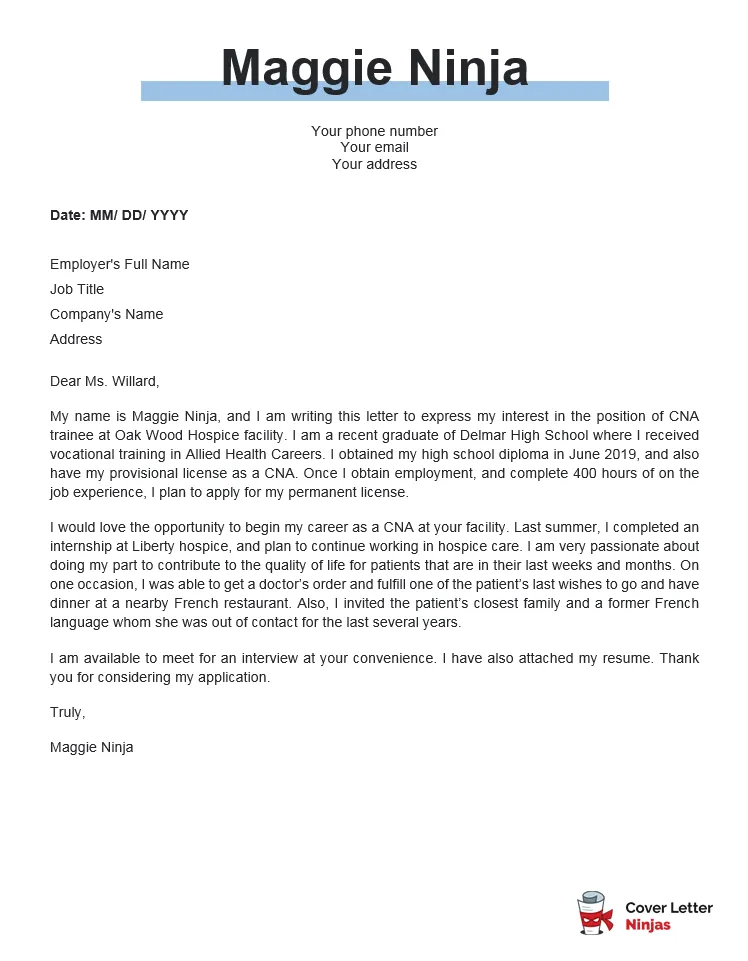
Briefly mention your career goals and how this position aligns with your aspirations. This shows that you have a clear vision for your future and that you are seeking a long-term commitment. For example, you could state that you aspire to become a lead CNA, pursue further education in nursing, or contribute to the improvement of patient care at the facility. Aligning your goals with the company’s mission demonstrates your intention to be a valuable asset to the organization. This showcases your proactiveness and the understanding that this role is not just a job, but a step towards building a career within the field of healthcare.
Tailoring Your Cover Letter to the Job
Tailor your cover letter to each specific job application to increase your chances of success. Carefully review the job description and identify the key skills and qualifications the employer is seeking. Then, use your cover letter to emphasize how your skills and experiences match those requirements. Do not simply send out a generic cover letter. Customize it to reflect the specific needs of the employer. By demonstrating that you understand the job requirements and are a perfect fit, you significantly increase your chances of being noticed.
Researching the Employer
Before you start writing, research the employer to show that you understand their mission, values, and the patients they serve. Visit the facility’s website, read online reviews, and, if possible, connect with current or former employees to gain insights into the work environment. This information will help you tailor your cover letter to the employer’s specific needs and demonstrate your genuine interest in the organization. Mentioning specific aspects of the facility or its mission in your cover letter shows that you have taken the time to learn about the organization and are genuinely interested in working there.
Customizing Your Letter
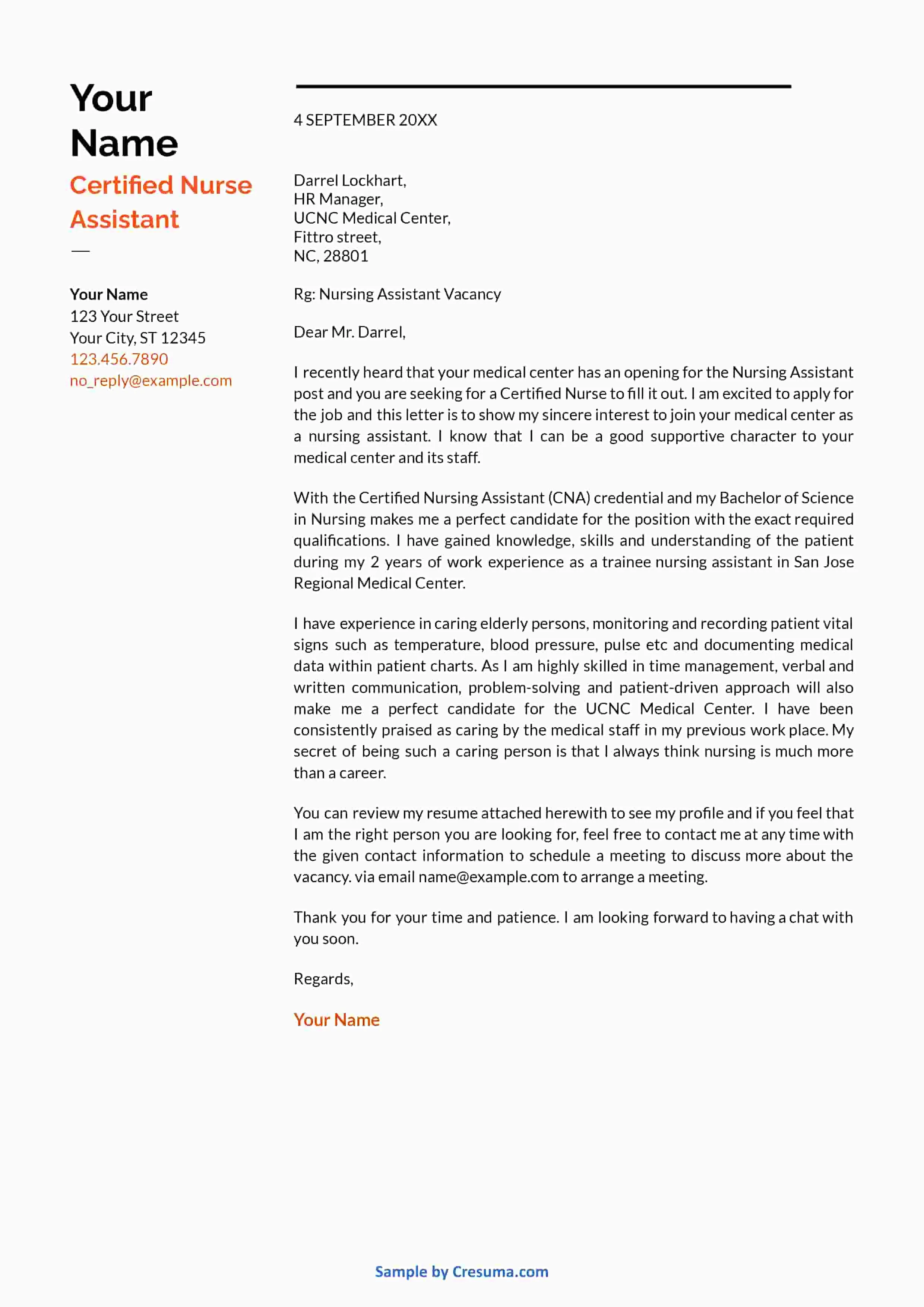
Once you have researched the employer and understood their requirements, customize your letter to reflect those needs. Instead of using a generic template, use the information you have gathered to highlight the skills and experiences that align with the job description. Use keywords and phrases from the job posting in your cover letter. This will demonstrate that you understand what the employer is looking for and that you can fulfil their specific needs. By showcasing your understanding of the specific requirements of the role, you present yourself as the ideal candidate who can make immediate contributions to the team.
Formatting and Structure for Readability
Ensure your cover letter is easy to read and visually appealing. Use a professional format with clear headings, concise paragraphs, and adequate spacing. Maintain consistency in font style and size throughout the document. The format of your cover letter reflects your attention to detail and professionalism. A well-formatted letter not only looks polished but is also easier to read and comprehend. This makes it more likely that the hiring manager will read the entire letter, increasing your chances of making a favorable impression and being offered an interview.
Choosing the Right Font and Layout
Choose a professional font like Times New Roman, Arial, or Calibri, using a font size between 10 and 12 points. These fonts are universally readable and project a sense of professionalism. Use single-spaced paragraphs with a space between each paragraph for better readability. Left-align your text and avoid excessive use of bolding or italics. A clean layout makes the cover letter easier to read and ensures that the focus remains on your qualifications and experience, ensuring your message is clear and persuasive to the hiring manager.
Proofreading and Editing Your Cover Letter
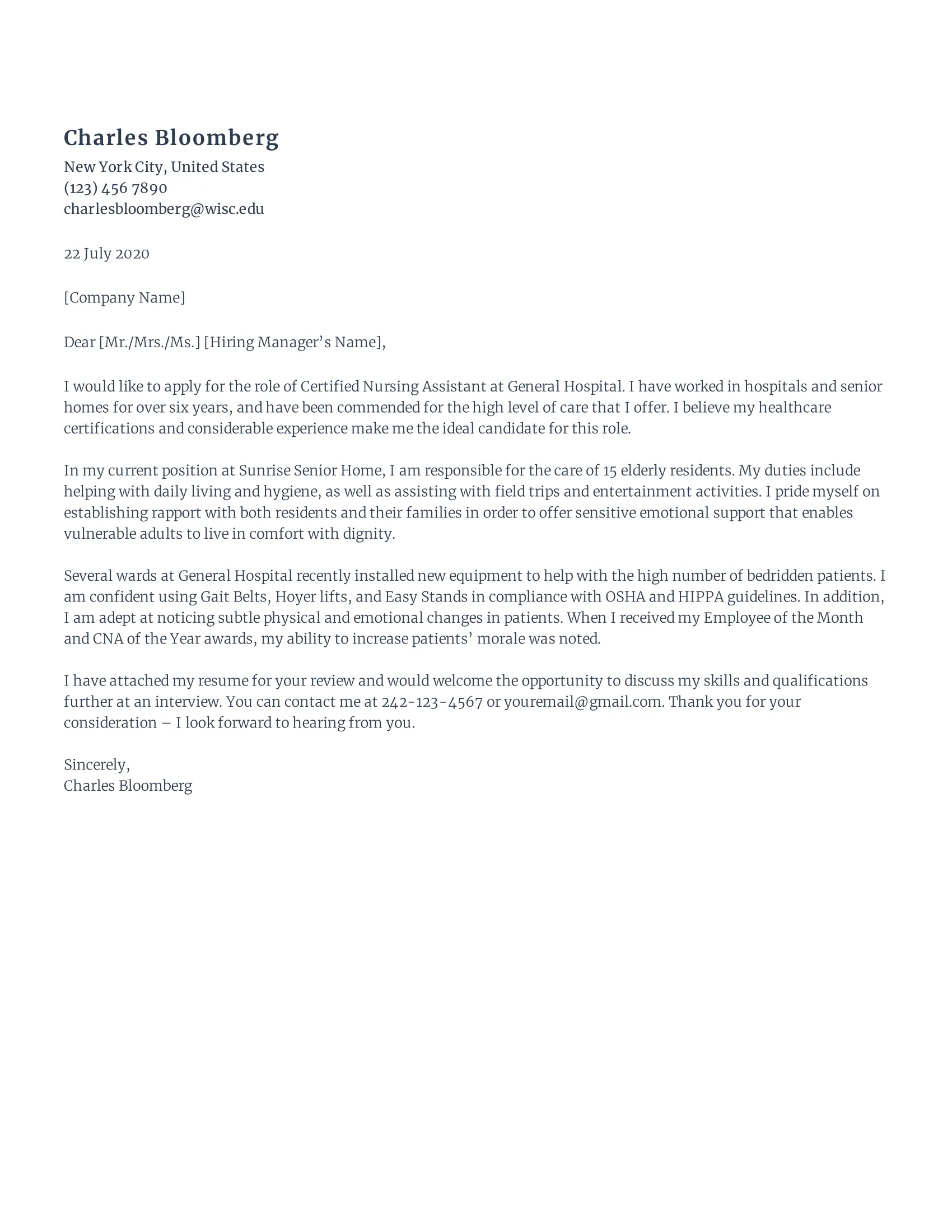
Proofreading and editing are essential to ensure your cover letter is error-free and polished. Check for spelling, grammar, and punctuation errors. Ask a friend, family member, or career advisor to review your letter. Errors can undermine your credibility and make you appear unprofessional. A perfectly polished cover letter reflects your professionalism and attention to detail, making a positive impression on the hiring manager and increasing your chances of landing an interview. Carefully reviewing and editing is one of the most important steps in the application process.
Ensuring Clarity and Conciseness
Keep your cover letter concise and to the point. Aim for a one-page letter, highlighting your most relevant skills and experiences. Use clear and direct language. Avoid jargon or overly complex sentences. Each sentence should contribute to the overall message and showcase your qualifications. Clarity and conciseness demonstrate that you respect the reader’s time and can communicate effectively. Ensure every word serves a purpose. The easier it is to read and understand your letter, the more likely it is that the hiring manager will take the time to consider your application fully.
Common Mistakes to Avoid
There are several common mistakes to avoid when writing a CNA cover letter. Addressing these mistakes can significantly improve the impact of your letter. Avoiding these common pitfalls ensures your cover letter presents you in the best possible light and increases your chances of getting an interview.
Generic Cover Letters
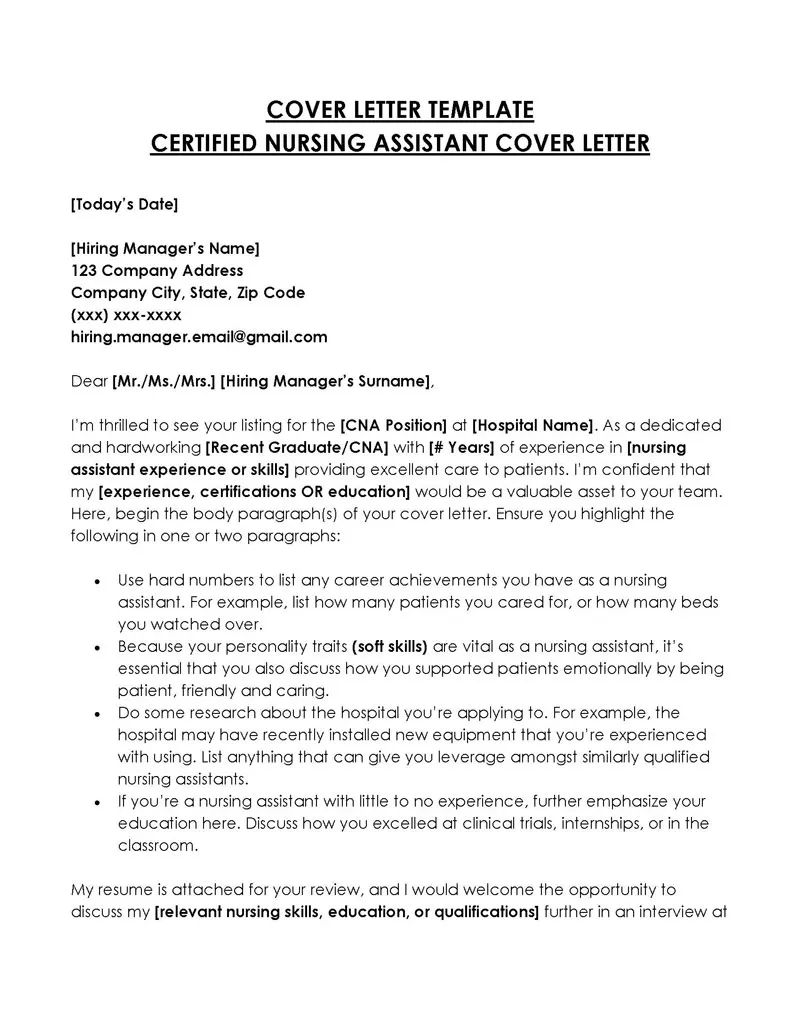
Avoid sending generic cover letters that are not tailored to the specific job or company. Generic letters fail to convey your genuine interest in the position and can easily be discarded. Instead, customize each letter to reflect the specific requirements of the job and the values of the employer. Taking the time to personalize your letter demonstrates that you are dedicated to the opportunity and have a genuine interest in working for the organization. Show that you care enough to put in the extra effort.
Typos and Grammatical Errors
Typos and grammatical errors can create a negative impression and make you appear unprofessional. Always proofread your cover letter carefully before submitting it. Use spell-check and grammar-check tools. Consider having a friend or family member review your letter for errors. Ensure your cover letter is free of errors so that it highlights your attention to detail and your commitment to excellence, making a positive impression on the hiring manager. Proofreading and attention to detail are critical for demonstrating your professionalism.
The Importance of a Strong Closing
A strong closing reinforces your interest in the position and encourages the hiring manager to take the next step. The closing of your cover letter is as important as the opening. It provides a final opportunity to reiterate your interest and encourage further action. End your letter with a clear call to action and express your thanks for the hiring manager’s time and consideration. This final impression can be a critical element in securing an interview and ultimately, the job.
Thanking the Hiring Manager
Thank the hiring manager for their time and consideration. This simple act of gratitude demonstrates your professionalism and respect for their role. By expressing your appreciation, you leave a positive impression that makes a lasting impact, showing courtesy and a genuine interest in the opportunity. This will enhance the overall impression of your application.
Including a Call to Action
End your cover letter with a call to action. Encourage the hiring manager to contact you for an interview or to discuss your qualifications further. Clearly stating your desire to move forward in the hiring process reinforces your interest in the position and makes it easy for the hiring manager to take the next step. This gives the hiring manager a clear direction and a reason to follow up. A well-placed call to action can be the final element that sets you apart from other candidates.
Cover Letter Examples and Templates
To help you get started, review examples of CNA cover letters and templates. This will provide a framework for structuring your own letter and give you ideas for how to highlight your skills and experiences. Use these examples as a starting point to craft a cover letter that is tailored to your specific qualifications and the job requirements. While templates are helpful, remember to customize each one to reflect your unique background and the specific demands of the position you are applying for. Personalization is key.
Writing a compelling CNA cover letter is an investment in your career. By following these guidelines, you can create a cover letter that effectively showcases your skills, experience, and passion for patient care. Take the time to personalize your letter for each job application, and proofread carefully. Your effort will result in a cover letter that captures the attention of hiring managers and lands you your dream job as a CNA. Remember that the cover letter is your voice and opportunity to shine. Good luck with your job search!
